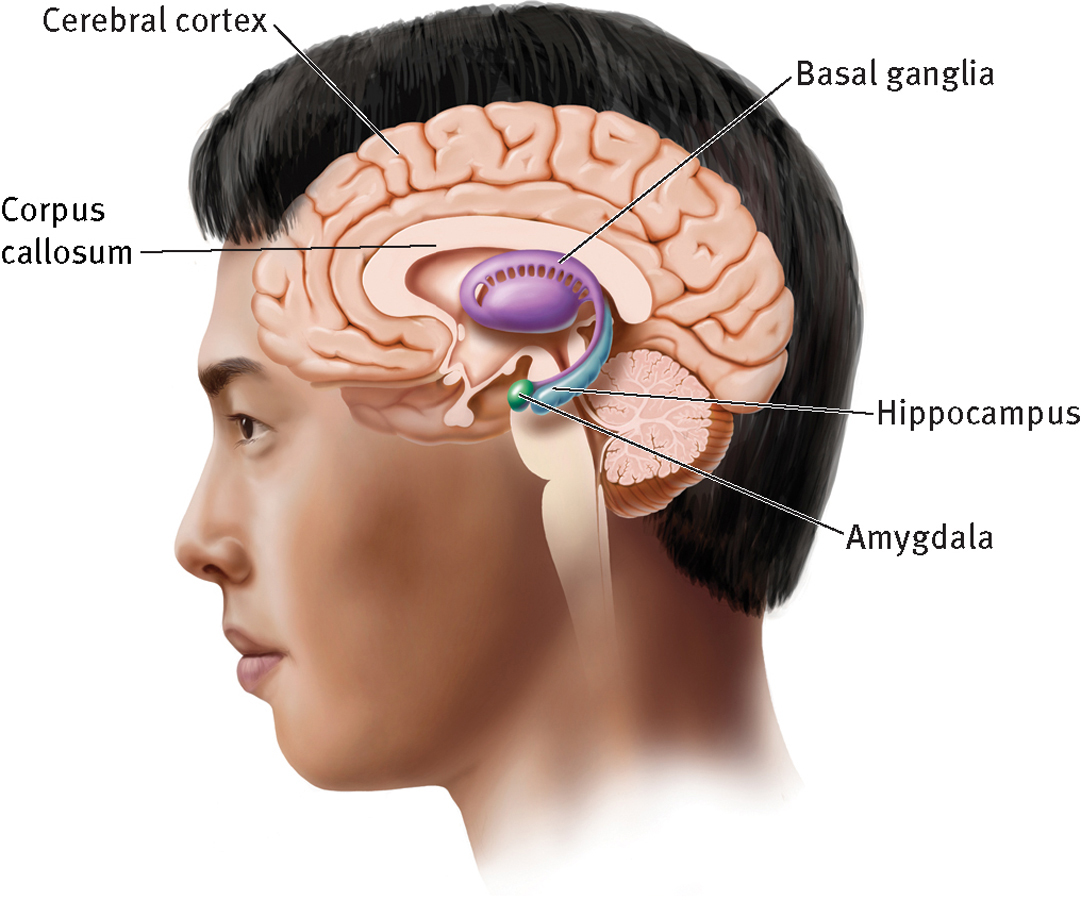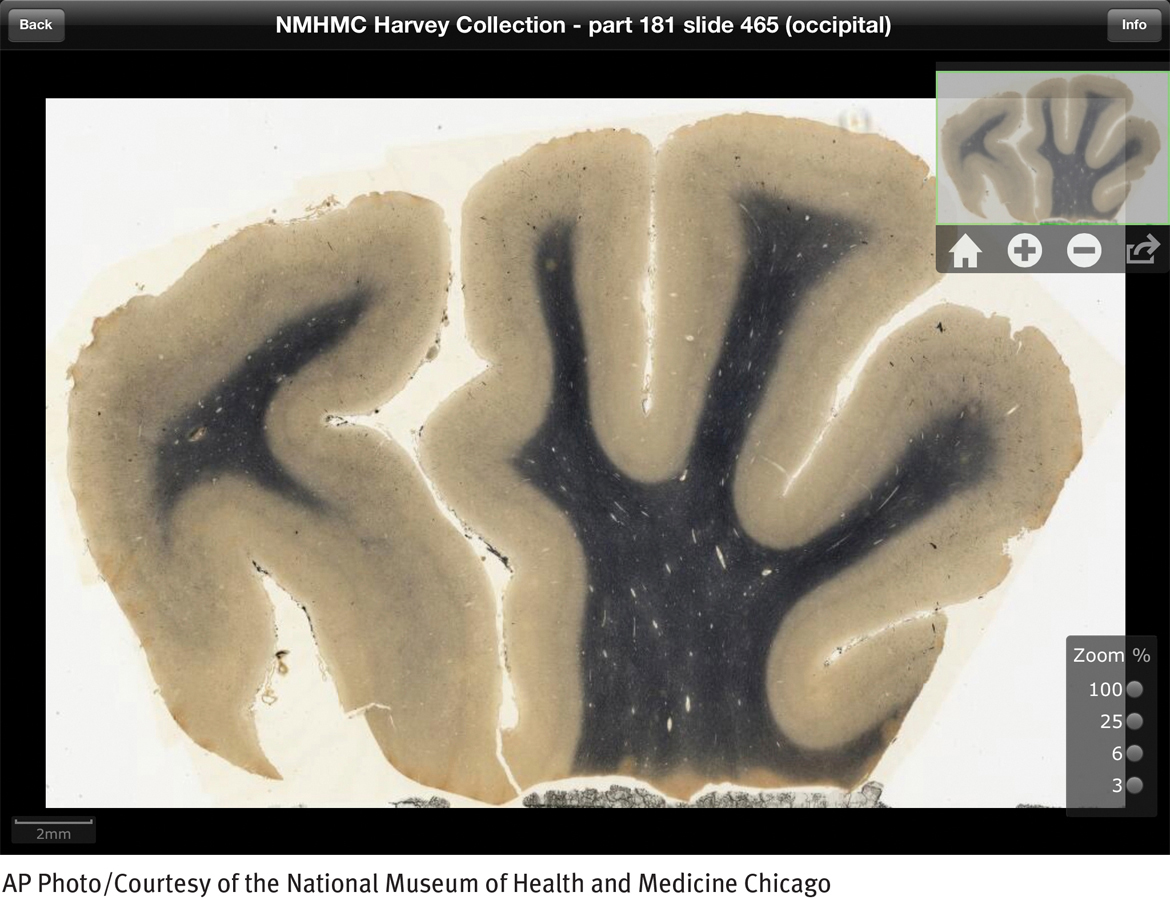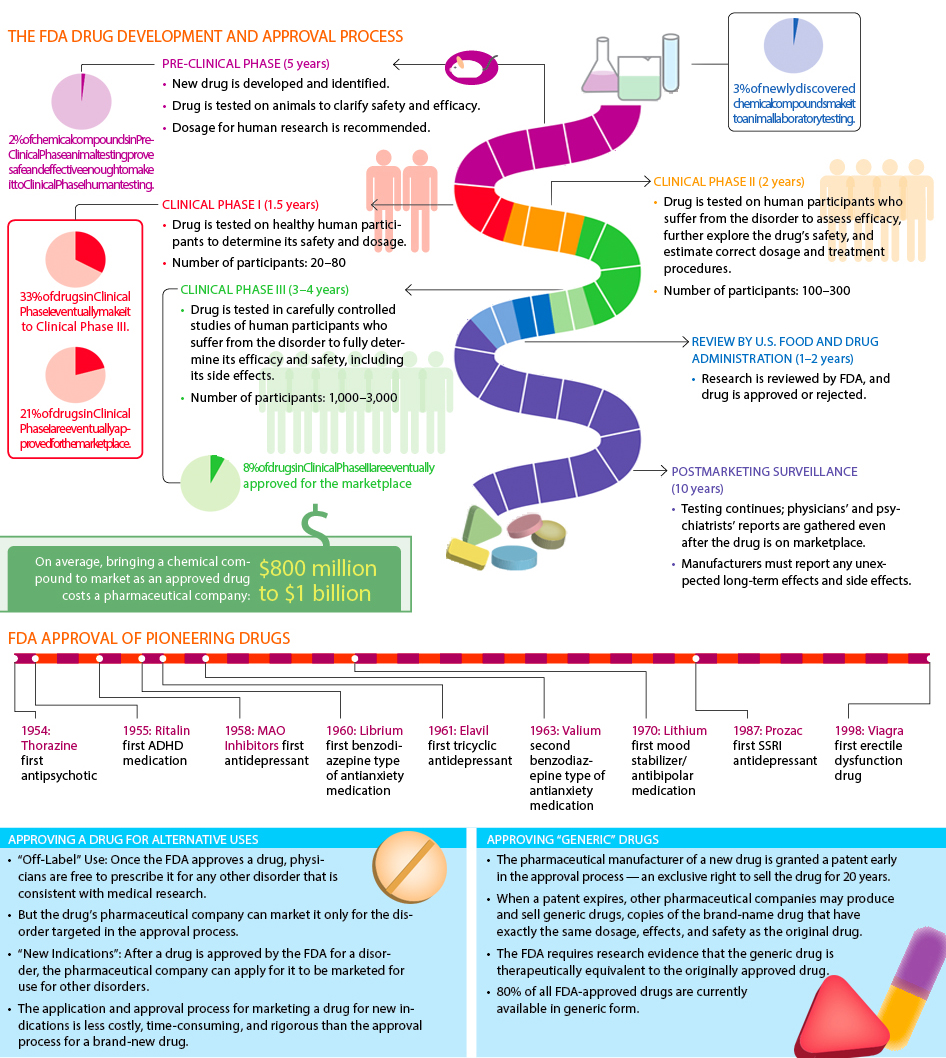3.1 The Biological Model
Philip Berman is a biological being. His thoughts and feelings are the results of biochemical and bioelectrical processes throughout his brain and body. Proponents of the biological model believe that a full understanding of Philip’s thoughts, emotions, and behavior must therefore include an understanding of their biological basis. Not surprisingly, then, they believe that the most effective treatments for Philip’s problems will be biological ones.
How Do Biological Theorists Explain Abnormal Behavior?
Adopting a medical perspective, biological theorists view abnormal behavior as an illness brought about by malfunctioning parts of the organism. Typically, they point to problems in brain anatomy or brain chemistry as the cause of such behavior.
Brain Anatomy and Abnormal BehaviorThe brain is made up of approximately 100 billion nerve cells, called neurons, and thousands of billions of support cells, called glia (from the Greek word for “glue”). Within the brain large groups of neurons form distinct areas, or brain regions. Toward the top of the brain, for example, is a cluster of regions, collectively referred to as the cerebrum, which includes the cortex, corpus callosum, basal ganglia, hippocampus, and amygdala (see Figure 3-1). The neurons in each of these brain regions control important functions. The cortex is the outer layer of the brain, the corpus callosum connects the brain’s two cerebral hemispheres, the basal ganglia plays a crucial role in planning and producing movement, the hippocampus helps regulate emotions and memory, and the amygdala plays a key role in emotional memory. Clinical researchers have discovered connections between certain psychological disorders and problems in specific areas of the brain. One such disorder is Huntington’s disease, a disorder marked by violent emotional outbursts, memory loss, suicidal thinking, involuntary body movements, and absurd beliefs. This disease has been traced to a loss of cells in the basal ganglia and cortex.
 neuron A nerve cell.
neuron A nerve cell.

The cerebrum
Some psychological disorders can be traced to abnormal functioning of neurons in the cerebrum, which includes brain structures such as the cerebral cortex, corpus callosum, basal ganglia, hippocampus, and amygdala.
Brain Chemistry and Abnormal BehaviorBiological researchers have also learned that psychological disorders can be related to problems in the transmission of messages from neuron to neuron. Information is communicated throughout the brain in the form of electrical impulses that travel from one neuron to one or more others. An impulse is first received by a neuron’s dendrites, antenna-

A neuron communicating information
A message in the form of an electrical impulse travels down the sending neuron’s axon to its nerve ending, where neurotransmitters are released and carry the message across the synaptic space to the dendrites of a receiving neuron.
But how do messages get from the nerve ending of one neuron to the dendrites of another? After all, the neurons do not actually touch each other. A tiny space, called the synapse, separates one neuron from the next, and the message must somehow move across that space. When an electrical impulse reaches a neuron’s ending, the nerve ending is stimulated to release a chemical, called a neurotransmitter, that travels across the synaptic space to receptors on the dendrites of the neighboring neurons. After binding to the receiving neuron’s receptors, some neurotransmitters give a message to receiving neurons to “fire,” that is, to trigger their own electrical impulse. Other neurotransmitters carry an inhibitory message; they tell receiving neurons to stop all firing. As you can see, neurotransmitters play a key role in moving information through the brain.
 synapse The tiny space between the nerve ending of one neuron and the dendrite of another.
synapse The tiny space between the nerve ending of one neuron and the dendrite of another.
 neurotransmitter A chemical that, released by one neuron, crosses the synaptic space to be received at receptors on the dendrites of neighboring neurons.
neurotransmitter A chemical that, released by one neuron, crosses the synaptic space to be received at receptors on the dendrites of neighboring neurons.
 receptor A site on a neuron that receives a neurotransmitter.
receptor A site on a neuron that receives a neurotransmitter.
Researchers have identified dozens of neurotransmitters in the brain, and they have learned that each neuron uses only certain kinds. Studies indicate that abnormal activity by certain neurotransmitters can lead to specific mental disorders. Depression, for example, has been linked to low activity of the neurotransmitters serotonin and norepinephrine. Perhaps low serotonin activity is partly responsible for Philip Berman’s pattern of depression and rage.
In addition to focusing on neurons and neurotransmitters, researchers have learned that mental disorders are sometimes related to abnormal chemical activity in the body’s endocrine system. Endocrine glands, located throughout the body, work along with neurons to control such vital activities as growth, reproduction, sexual activity, heart rate, body temperature, energy, and responses to stress. The glands release chemicals called hormones into the bloodstream, and these chemicals then propel body organs into action. During times of stress, for example, the adrenal glands, located on top of the kidneys, secrete the hormone cortisol to help the body deal with the stress. Abnormal secretions of this chemical have been tied to anxiety and mood disorders.
 hormones The chemicals released by endocrine glands into the bloodstream.
hormones The chemicals released by endocrine glands into the bloodstream.

Sources of Biological AbnormalitiesWhy do some people have brain structures or biochemical activities that differ from the norm? Three factors have received particular attention in recent years—
GENETICS AND ABNORMAL BEHAVIORAbnormalities in brain anatomy or chemistry are sometimes the result of genetic inheritance. Each cell in the human brain and body contains 23 pairs of chromosomes, with each chromosome in a pair inherited from one of the person’s parents. Every chromosome contains numerous genes—segments that control the characteristics and traits a person inherits. Altogether, each cell contains around 30,000 genes (Emig et al., 2013; Dermitzakis, 2011). Scientists have known for years that genes help determine such physical characteristics as hair color, height, and eyesight. Genes can make people more prone to heart disease, cancer, or diabetes, and perhaps to possessing artistic or musical skill. Studies suggest that inheritance also plays a part in mood disorders, schizophrenia, and other mental disorders. It appears that in most cases, several genes combine to help produce our actions and reactions, both functional and dysfunctional.
 gene Chromosome segments that control the characteristics and traits we inherit.
gene Chromosome segments that control the characteristics and traits we inherit.
The precise contributions of various genes to mental disorders have become clearer in recent years, thanks in part to the completion of the Human Genome Project in 2000. In this major undertaking, scientists used the tools of molecular biology to map, or sequence, all of the genes in the human body in great detail. With this information in hand, researchers hope eventually to be able to prevent or change genes that help cause medical or psychological disorders.
EVOLUTION AND ABNORMAL BEHAVIORGenes that contribute to mental disorders are typically viewed as unfortunate occurrences—
In general, evolutionary theorists argue that human reactions and the genes responsible for them have survived over the course of time because they have helped individuals to thrive and adapt. Ancestors who had the ability to run fast, for example, or the craftiness to hide were most able to escape their enemies and to reproduce. Thus, the genes responsible for effective walking, running, or problem solving were particularly likely to be passed on from generation to generation to the present day.
Similarly, say evolutionary theorists, the capacity to experience fear was, and in many instances still is, adaptive. Fear alerted our ancestors to dangers, threats, and losses, so that persons could avoid or escape potential problems. People who were particularly sensitive to danger—

The evolutionary perspective is controversial in the clinical field and has been rejected by many theorists. Imprecise and at times impossible to research, this explanation requires leaps of faith that many scientists find unacceptable. Nevertheless, as genetic discoveries and insights have grown, interest in the possible causes of genetic differences and how they relate to current circumstances has grown as well, and evolutionary theories have received considerable attention.
VIRAL INFECTIONS AND ABNORMAL BEHAVIORAnother possible source of abnormal brain structure or biochemical dysfunctioning is viral infections. As you will see in Chapter 14, for example, research suggests that schizophrenia, a disorder marked by delusions, hallucinations, or other departures from reality, may be related to exposure to certain viruses during childhood or before birth (Liu et al., 2014; Arias et al., 2012). Studies have found that the mothers of many individuals with this disorder contracted influenza or related viruses during their pregnancy. This and related pieces of circumstantial evidence suggest that a damaging virus may enter the fetus’ brain and remain dormant there until the individual reaches adolescence or young adulthood. At that time, the virus may produce the symptoms of schizophrenia. During the past decade, researchers have sometimes linked viruses to anxiety, depressive, and bipolar disorders, as well as to psychotic disorders (Liu et al, 2014; Fox, 2010).
Biological Treatments
Biological practitioners look for certain kinds of clues when they try to understand abnormal behavior. Does the person’s family have a history of that behavior, and hence a possible genetic predisposition to it? (Philip Berman’s case history mentions that his mother was once hospitalized for depression.) Is the behavior produced by events that could have had a physiological effect? (Philip was having a drink when he flew into a jealous rage at the restaurant.)
Once the clinicians have pinpointed physical sources of dysfunctioning, they are in a better position to choose a biological course of treatment. The three leading kinds of biological treatments used today are drug therapy, electroconvulsive therapy, and psychosurgery. Drug therapy is by far the most common of these approaches.
What might the popularity of psychotropic drugs suggest about coping styles and problem-
In the 1950s, researchers discovered several effective psychotropic medications, drugs that mainly affect emotions and thought processes. These drugs have greatly changed the outlook for a number of mental disorders and today are used widely, either alone or with other forms of therapy. However, the psychotropic drug revolution has also produced some major problems. Many people believe, for example, that the drugs are overused. Moreover, while drugs are effective in many cases, they do not help everyone.
 psychotropic medications Drugs that primarily affect the brain and reduce many symptoms of mental dysfunctioning.
psychotropic medications Drugs that primarily affect the brain and reduce many symptoms of mental dysfunctioning.
BETWEEN THE LINES
In Their Words
“My brain? That’s my second favorite organ.”
Woody Allen
Four major psychotropic drug groups are used in therapy: antianxiety, antidepressant, antibipolar, and antipsychotic drugs. Antianxiety drugs, also called minor tranquilizers or anxiolytics, help reduce tension and anxiety. Antidepressant drugs help improve the mood of people who are depressed. Antibipolar drugs, also called mood stabilizers, help steady the moods of those with a bipolar disorder, a condition marked by mood swings from mania to depression. And antipsychotic drugs help reduce the confusion, hallucinations, and delusions of psychotic disorders, disorders (such as schizophrenia) marked by a loss of contact with reality. All such drugs reach the marketplace only after systematic research and a careful review process (see InfoCentral below).
 antianxiety drugs Psychotropic drugs that help reduce tension and anxiety. Also called minor tranquilizers or anxiolytics.
antianxiety drugs Psychotropic drugs that help reduce tension and anxiety. Also called minor tranquilizers or anxiolytics.
 antidepressant drugs Psychotropic drugs that improve the moods of people with depression.
antidepressant drugs Psychotropic drugs that improve the moods of people with depression.
 antibipolar drugs Psychotropic drugs that help stabilize the moods of people suffering from a bipolar mood disorder. Also called mood stabilizers.
antibipolar drugs Psychotropic drugs that help stabilize the moods of people suffering from a bipolar mood disorder. Also called mood stabilizers.
 antipsychotic drugs Psychotropic drugs that help correct the confusion, hallucinations, and delusions found in psychotic disorders.
antipsychotic drugs Psychotropic drugs that help correct the confusion, hallucinations, and delusions found in psychotic disorders.

A second form of biological treatment, used primarily on depressed patients, is electroconvulsive therapy (ECT). Two electrodes are attached to a patient’s forehead, and an electrical current of 65 to 140 volts is passed briefly through the brain. The current causes a brain seizure that lasts up to a few minutes. After seven to nine ECT sessions, spaced two or three days apart, many patients feel considerably less depressed. The treatment is used on tens of thousands of depressed persons annually, particularly those whose depression fails to respond to other treatments (Dukart et al., 2014; Perugi et al., 2012).
 electroconvulsive therapy (ECT) A biological treatment in which a brain seizure is triggered as an electric current passes through electrodes attached to the patient’s forehead.
electroconvulsive therapy (ECT) A biological treatment in which a brain seizure is triggered as an electric current passes through electrodes attached to the patient’s forehead.
A third form of biological treatment is psychosurgery, or neurosurgery, brain surgery for mental disorders. It is thought to have roots as far back as trephining, the prehistoric practice of chipping a hole in the skull of a person who behaved strangely. Modern procedures are derived from a technique first developed in the late 1930s by a Portuguese neuropsychiatrist, António Egas Moniz. In that procedure, known as a lobotomy, a surgeon would cut the connections between the brain’s frontal lobes and the lower regions of the brain. Today’s psychosurgery procedures are much more precise than the lobotomies of the past. Even so, they are considered experimental and are used only after certain severe disorders have continued for years without responding to any other form of treatment.
 psychosurgery Brain surgery for mental disorders. Also called neurosurgery.
psychosurgery Brain surgery for mental disorders. Also called neurosurgery.
InfoCentral
DRUG APPROVAL
How does a new drug reach the marketplace? It takes an average of 12 to 13 years and many millions of dollars for a pharmaceutical company in the United States to bring a new drug to market. The company must carefully follow steps that are specified by law. The journey begins with the laboratory discovery of a promising chemical compound. Only a small percentage of such compounds ever make it all the way.

Assessing the Biological Model
Today the biological model enjoys considerable respect. Biological research constantly produces valuable new information. And biological treatments often bring great relief when other approaches have failed. At the same time, this model has its shortcomings. Some of its proponents seem to expect that all human behavior can be explained in biological terms and treated with biological methods. This view can limit rather than enhance our understanding of abnormal functioning. Our mental life is an interplay of biological and nonbiological factors, and it is important to understand that interplay rather than to focus on biological variables alone.
Another shortcoming is that several of today’s biological treatments are capable of producing significant undesirable effects. Certain antipsychotic drugs, for example, may produce movement problems such as severe shaking, bizarre-